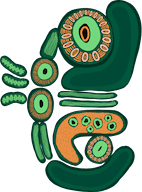
Let us help you decipher dentist lingo
Many of us have had the experience of sitting in the dentist chair and thinking they’re talking another language. This is because dentists and their dental assistant use dental terminology to describe conditions of the teeth and mouth. This terminology helps to record accurate information and save time. To patients their words can be confusing – until now.
Read on to understand more about the terminology dentists use and what it all means. And importantly, don’t hesitate to ask your dentist or dental assistant to explain what they’re saying.
Your mouth is divided into quadrants
Dentists divide your mouth into four separate regions known as quadrants. The upper part of your mouth forms the first two quadrants and the lower part of your mouth the third and fourth quadrants. Working clockwise, your top right side is quadrant 1, top left is 2, lower left is 3 and lower right is 4. Each tooth also has it’s own individual identifying number, for example, tooth #1 is your front tooth, working backwards into the mouth, your next tooth is #2 and this continues up to tooth #8, if you have all of your teeth present in that quadrant. When your dentist is examining your teeth, they will often call out two numbers.
Why so many teeth?
You may hear your dentist name your teeth as incisors, canines, premolars and molars, or third molars (wisdom teeth). Each of your teeth serves a special function to bite, grind and soften food so it’s safe to swallow.
It’s not only numbers which are code for your teeth and where they are located, your dentist will also use number and word combinations to describe what they’re seeing. For example, you may hear them say words like, mesial (closest to the front of the mouth), lateral (side), incisal (cutting side) distal (closer to the back of the mouth) which are commonly used to explain which portion of a tooth they’re examining.
When a tooth has had previous treatment, there is also a special way of relating what’s been done. Restorations may be described as being made from composite, resin or amalgam. When a tooth is missing, decayed or filled, your dentist will also describe the condition of any restorations and if they are still in good condition or need replacing.
Handy dental terms
- Bruxism – clenching or grinding your teeth
- Root canal therapy – the removal of infection from a tooth
- Crown – made of strong dental material such as porcelain or metal to cover the entire tooth -like a crash helmet for a damaged tooth
- Occlusal splint – a night guard worn if you’re clenching and grinding
- Dental implant – a replacement for a missing tooth root in your jaw bone made from pure titanium . Used to anchor a new crown, bridge or denture
- IV sedation – known as ‘twilight or sleep dentistry’
- Abscess – acute or chronic infection in the gum or tooth
- Bridge – a procedure to replace one or more missing teeth using the teeth either side of the gap to hold it in permanently in place
- Calculus – another word for tartar, which is is a hard mineral deposit on the tooth surface
- Canine teeth – also known as the eye teeth used for slicing and tearing into food. There are two canines in the upper and lower jaws
- Tooth Decay – also known as holes or cavities. This is the result of tooth enamel and dentine becoming soft and infected by bacteria in the mouth
- Dentine – the yellowish tissue that makes up most of a tooth, located beneath the enamel which is the white, hard outer layer
- Dentures – false teeth made of acrylic or metal; can be complete (replacing all teeth) or partial (filling in spaces left by missing teeth)
- Enamel – the white part of the tooth you can see above the gums. It is the hardest substance in the body
- Erosion – the loss of tooth enamel due to acid attack
- Filling – used to replace lost tooth structure following tooth decay, erosion, fracture or trauma. Commonly made from tooth coloured materials such as composite resin
- Fluoride – a natural mineral found in toothpaste and water that strengthens tooth enamel and prevents decay
- Gingivitis – an early form of gum disease characterised by inflamed or bleeding gums as a result of plaque bacteria build-up along the gum line
- Hygienist – a dental practitioner specialising in the prevention of dental disease and the promotion of good oral health
- Incisor – a front tooth used for slicing into food. There are 4 incisors in the upper and lower jaws
- Mandible – the lower jaw
- Maxilla – the upper jaw
- Molar – teeth used for grinding, located on both sides of the jaw. There are up to 6 molars in the upper and lower jaws
- Orthodontist – a dental professional who specialises in dental and facial irregularities such as crooked teeth and mismatched bites
- Periodontal disease – an advanced gum disease which may occur if gingivitis isn’t treated
- Periodontal ligament – tissue that separates the tooth from the bone socket, and anchors the tooth to the bone
- Plaque – a soft, sticky substance comprised of bacteria and similar substances that build up on teeth
- Premolars – teeth with a flat biting surface, used for tearing and crushing food. There are 4 premolars in the upper and lower jaws
- Pulp – the living tissue at the centre of each tooth containing nerves, blood vessels and connective tissue
- Scaling – the process of removing harmful substances such as plaque, tartar and stain from teeth
- Sealant – a material applied to biting surfaces of newly erupted back teeth to prevent cavities forming
- Tartar – when plaque isn’t cleaned away, it can harden into tartar. Dentists will also sometimes call this calculus
- Veneer – a thin layer of material made to cover the front surface of a tooth to improve its appearance or position
Book an appointment with your dentist to put your new knowledge into practice. You may want to ask them how your 13 is looking!
